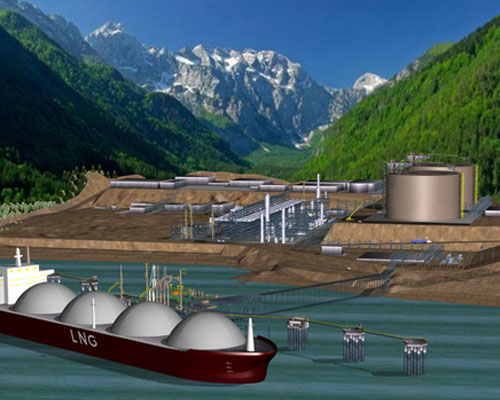

Two Canadian energy companies are closer to developing export facilities for liquefied natural gas in the Pacific Northwest, driven by burgeoning demand for natural gas in Asia and vast North American natural-gas reserves. Other companies are also queuing up to export natural gas.
Last month, B.C.-based Kitimat LNG received a 20-year export license from Canada’s National Energy Board to develop a
$5.7- billion LNG terminal and pipeline to ship natural gas to the Asia-Pacific region. A few weeks later, the U.S. Dept. of Energy awarded a 30-year license to Veresen’s Jordan Cove Energy Project to export natural gas from a proposed $3.5-billion LNG terminal in Coos Bay, Ore.
That facility, says project manager Bob Braddock, will mean “an enormous tax base,” 600 construction jobs and work for local engineering consultants. “The contractors are a consortia team made up of Black & Veatch, Peter Kiewit plus two French companies," says Braddock. "But most of that work gets subcontracted out, drawing upon skills available in the Pacific Northwest.”
Equally important, says Braddock, will be development of associated pipeline to transport natural gas east of the Cascades to domestic markets in Seattle, Portland and Eugene, Ore. That “missing piece in the build-out of the Pacific Northwest gas grid” is a step closer with the recent announcement that Veresen partner Pacific Connector Gas Pipeline LP has been issued a certificate to build and operate a 234-mile, 36-in.-dia natural-gas pipeline into the region.
Further north, a front-end engineering and design study is under way for Kitimat’s LNG facility, which would process 700 million cu ft of gas a day. The natural gas would be transported southward from the Horn River area along the existing Spectra pipelines system to Summit Lake, then make its way to the LNG facility along a proposed 463-kilometer, 36-in.-dia pipeline. Asian demand is driving these proposals and helped Kitimat LNG win its export license, says Paul Wyke, senior adviser to Kitimat LNG partner Apache Canada Ltd.
“Japan and Korea combined to import 47% of the world’s LNG in 2010, and that demand is also expected to grow in the next 10 to 20 years. These markets have a tremendous need to secure long-term contracts for a stable and secure source of LNG,” says Wyke.
In March 2011, Douglas Channel Gas Services and its partners applied to the National Energy Board for a license to export LNG from a proposed facility at Douglas Channel near Kitimat, pointing out that “there has never been [an] LNG export permitted from Canada.” Douglas Channel would like to be the first to begin to fill Asia's demand, as would Shell Canada, Malaysia's state-owned oil company Petronas and even the local Haisla First Nation. Each is teaming up with a variety of domestic and international partners to submit their own proposals for an LNG facility in northern B.C.
B.C. Premier Christy Clark views LNG development as an important jobs creator and has promised to invest in training and international marketing for LNG and accelerate the lengthy government permitting process. The timing, says media spokeswoman Sandra Steilo, is critical. “There are multiple competing LNG export projects being proposed all over the world, and we need to make sure B.C. can meet the demands of new, growing markets before others do,” says Steilo. The province is also under pressure to diversify as the U.S. becomes increasingly less dependent upon B.C. natural gas. Provincial revenues from oil and gas are expected to increase to $2.6 billion by 2016-17, with increasing natural-gas volumes and recovering prices.
One question that remains is how BC Hydro will meet the enormous power needs that the Kitimat LNG facility will require. According to Stelio, the project's first phase can be served via existing transmission facilities, making it the first LNG facility in the world to operate on clean hydroelectricity. The second phase, if built, will require upgrades to existing transmission infrastructure.
However, analysts say the Asian appetite for natural gas is not the only factor driving LNG development. Another is the enormous spread between the price of natural gas in North America and in Asia. In December, prices at southern Alberta’s AECO storage hub averaged $2.93 per gigajoule, the lowest in a decade, according to the online natural-gas exchange NGX. That exchange compares with Asia, where gas prices this year have reached as high as $16. The bottom line, says Bob Braddock, is that Asia wants North American natural gas and is prepared to pay for it. “Where the production gains are in North America, the consumption gains are certainly in Asia,” Braddock says.

Post a comment to this article
Report Abusive Comment